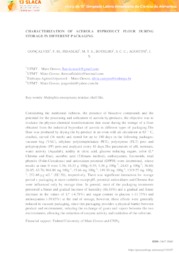Characterization of acerola byproduct flour during storage in different packaging.
Characterization of acerola byproduct flour during storage in different packaging.
Author(s): GONÇALVES, F. M.; FIDALSKI, M.; BOTELHO, S. de C. C.; AGOSTINI, J. da S.
Summary: Considering the nutritional richness, the presence of bioactive compounds and the potential for the processing and utilization of acerola by-products, the objective was to evaluate the physico-chemical transformations that occur during the storage of a flour obtained from the industrial byproduct of acerola in different types of packaging.The flour was produced by drying the by-product in an oven with air circulation at 65 ° C, crushed, sieved (16 mesh) and stored for up to 180 days in the following packages: vacuum bag (VAC), ethylene polytetraphthalate PET), polystyrene (PLT) pots and polypropylene (PP) pots and analyzed every 45 days.The parameters of pH, moisture, water activity (Aqualab), acidity in citric acid, glucose reducing sugars, color (L* Chroma and Hue), ascorbic acid (Tillmans method), anthocyanins, flavonoids, total phenols (Folin-Ciocalteau) and antioxidant potential (DPPH) were determined, whose results at time 0 were 3.56; 10.55 g 100g; 0.39; 5.36 g 100g-1; 24.63 g 100g-1; 36.60; 26.85; 63.76; 964.80 mg 100g-1; 15.66 mg 100g-1; 149.30 mg 100g-1; 1319.55 mg 100g- 1; 252.40 μg mL-1 (EC-50), respectively. There was significant interaction for storage period x packaging in most variables except pH, potential antioxidants and Chroma that were influenced only by storage time. In general, most of the packaging treatments presented a linear and gradual increase of humidity (66.16%) and a gradual and linear decrease in the values of L* (-4.78%) and sugar content in glucose (-11.73%) and anthocyanins (-39.85%) at the end of storage, however, these effects were generally reduced in vacuum packaging, since this packaging provides a physical barrier between product and environment, reducing the exchange of gases and vapors between the two environments, allowing the reduction of enzyme activity and oxidation of the substrate.
Publication year: 2019
Types of publication: Abstract in annals or event proceedings
Keywords: Acerola, Armazenamento de Alimento, Malpighia emarginata, Shelf life
Observation
Some of Embrapa's publications are published as ePub files. To read them, use or download one of the following free software options to your computer or mobile device. Android: Google Play Books; IOS: iBooks; Windows and Linux: Calibre.
Access other publications
Access the Agricultural Research Database (BDPA) to consult Embrapa's full library collection and records.
Visit Embrapa Bookstore to purchase books and other publications sold by Embrapa.

